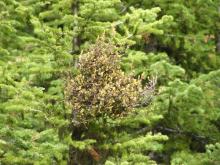Cause The fungus Melampsorella caryophyllacearum causes large brooms on true firs (Abies sp) including A. concolor (white fir), A. magnifica (California red fir) A. amabilis (Cascade fir), A. balsamea (balsam fir), A. grandis (grand fir), and A. lasiocarpa (alpine fir). The disease is found throughout the Pacific Northwest. The main problem is growth loss rather than poor wood quality. The disease is considered a forestry problem only in the Northern Rockies and in parts of California. Aeciospores are produced yearly on the fir host while uredinia and telia are produced on the chickweed (Cerastium sp. and Stellaria sp.) alternate host. Basidiospores from chickweed infect fir buds (leaves and new bark) as they open in the spring. Branches remain symptomless until the following spring when infected shoots emerge. The aecia develop and shed spores to chickweed in the summer. Uredinia develop within a few weeks of infection and continue to infect healthy plants and plant parts through the rest of the growing season. Telia develop in the fall and shed spores the next spring during fir bud break. The fungus can be systemic in perennial chickweeds.
Symptoms The first symptom may be an elongate swelling of the infected branch in the fall after spring infection. The spring after infection, infected shoots emerge, which are thicker and shorter than normal shoots. These shoots grow vertically from the infected branch, are pale yellow and very conspicuous in the summer. Needles on these shoots are short and thickened as well. Rust pustules (aecia) develop on the leaves. Leaves fall prematurely in August. Infected shoots continue to develop and branch yearly resulting in large brooms. Unlike brooms due to dwarf mistletoe, brooms bear yellow needles that die and drop in the fall making the broom appear bare and dead. The infected branch becomes swollen at the base of the broom into a spindle-shaped or sometimes nearly spherical gall.
Cultural control
- Remove brooms well below the swollen part of the branch.
- Remove trees with main stem infections early in the life of the stand.
- Chickweed eradication may be useful in the vicinity of high valued trees.
References Scharpf, R.F. 1993. Diseases of Pacific Coast Conifers. USDA Forest Service, Agriculture Handbook 521. Washington DC.
Ziller, W.G. 1974. The Tree Rusts of Western Canada. Canadian Forestry Service Publication 1329.


